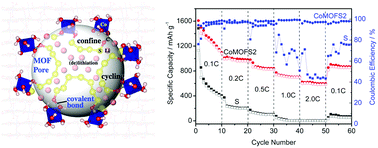当前位置:
X-MOL 学术
›
Sustain. Energy Fuels
›
论文详情
Our official English website, www.x-mol.net, welcomes your feedback! (Note: you will need to create a separate account there.)
Experimental and first-principles study of a metal–organic framework with sulfur embedding cathode for enhanced performance lithium–sulfur battery†
Sustainable Energy & Fuels ( IF 5.6 ) Pub Date : 2018-06-20 00:00:00 , DOI: 10.1039/c8se00195b Yan Feng 1, 2, 3, 4 , Yuliang Zhang 1, 2, 3, 4 , Guixiang Du 1, 2, 3, 4 , Jingbo Zhang 1, 2, 3, 4 , Xiaohui Qu 5, 6, 7, 8, 9
Sustainable Energy & Fuels ( IF 5.6 ) Pub Date : 2018-06-20 00:00:00 , DOI: 10.1039/c8se00195b Yan Feng 1, 2, 3, 4 , Yuliang Zhang 1, 2, 3, 4 , Guixiang Du 1, 2, 3, 4 , Jingbo Zhang 1, 2, 3, 4 , Xiaohui Qu 5, 6, 7, 8, 9
Affiliation

|
Lithium–sulfur (Li–S) batteries, which are well-known and much studied rechargeable batteries, are very promising because of their low cost, environmental friendliness, very high specific capacity and superior energy density. However, applications of Li–S batteries have been obstructed by their fast capacity fading and low coulombic efficiency due to soluble polysulfide migration during charge/discharge cycling. Herein, we present a strategy utilizing cobalt metal–organic framework (CoMOF) with rough porous surface and defective structure as a host material for sulfur accommodation, which implements a CoMOF and S composite (CoMOF–S) as a cathode. Capacity retention of CoMOF–S cathode surpasses that of pure sulfur by 87.18% after 100 cycles at 0.1C, while achieving coulombic efficiency above 98% at a high rate of 2.0C. We reveal structural features by combining X-ray photoelectron spectroscopy (XPS) and density functional theory (DFT) calculations, which confirm the covalent bond connection between CoMOF and S. We attribute the excellent cycling performance to covalent bond immobilization of sulfur.
中文翻译:

具有硫嵌入阴极的金属有机框架的实验和第一性原理研究,用于增强性能的锂硫电池†
锂-硫(Li-S)电池是众所周知的且经过大量研究的可充电电池,因其成本低,对环境友好,比容量高和能量密度高而非常有前途。然而,由于在充电/放电循环过程中可溶性多硫化物的迁移,Li-S电池的快速容量衰减和库仑效率低阻碍了它们的应用。在本文中,我们提出了一种利用具有粗糙多孔表面和缺陷结构的钴金属-有机骨架(CoMOF)作为硫容纳的主体材料的策略,该策略将CoMOF和S复合材料(CoMOF-S)用作阴极。CoMOF–S阴极在0.1C循环100次后的容量保持率比纯硫高87.18%,而在2.0C的高速率下库仑效率达到98%以上。
更新日期:2018-06-20
中文翻译:

具有硫嵌入阴极的金属有机框架的实验和第一性原理研究,用于增强性能的锂硫电池†
锂-硫(Li-S)电池是众所周知的且经过大量研究的可充电电池,因其成本低,对环境友好,比容量高和能量密度高而非常有前途。然而,由于在充电/放电循环过程中可溶性多硫化物的迁移,Li-S电池的快速容量衰减和库仑效率低阻碍了它们的应用。在本文中,我们提出了一种利用具有粗糙多孔表面和缺陷结构的钴金属-有机骨架(CoMOF)作为硫容纳的主体材料的策略,该策略将CoMOF和S复合材料(CoMOF-S)用作阴极。CoMOF–S阴极在0.1C循环100次后的容量保持率比纯硫高87.18%,而在2.0C的高速率下库仑效率达到98%以上。


























 京公网安备 11010802027423号
京公网安备 11010802027423号